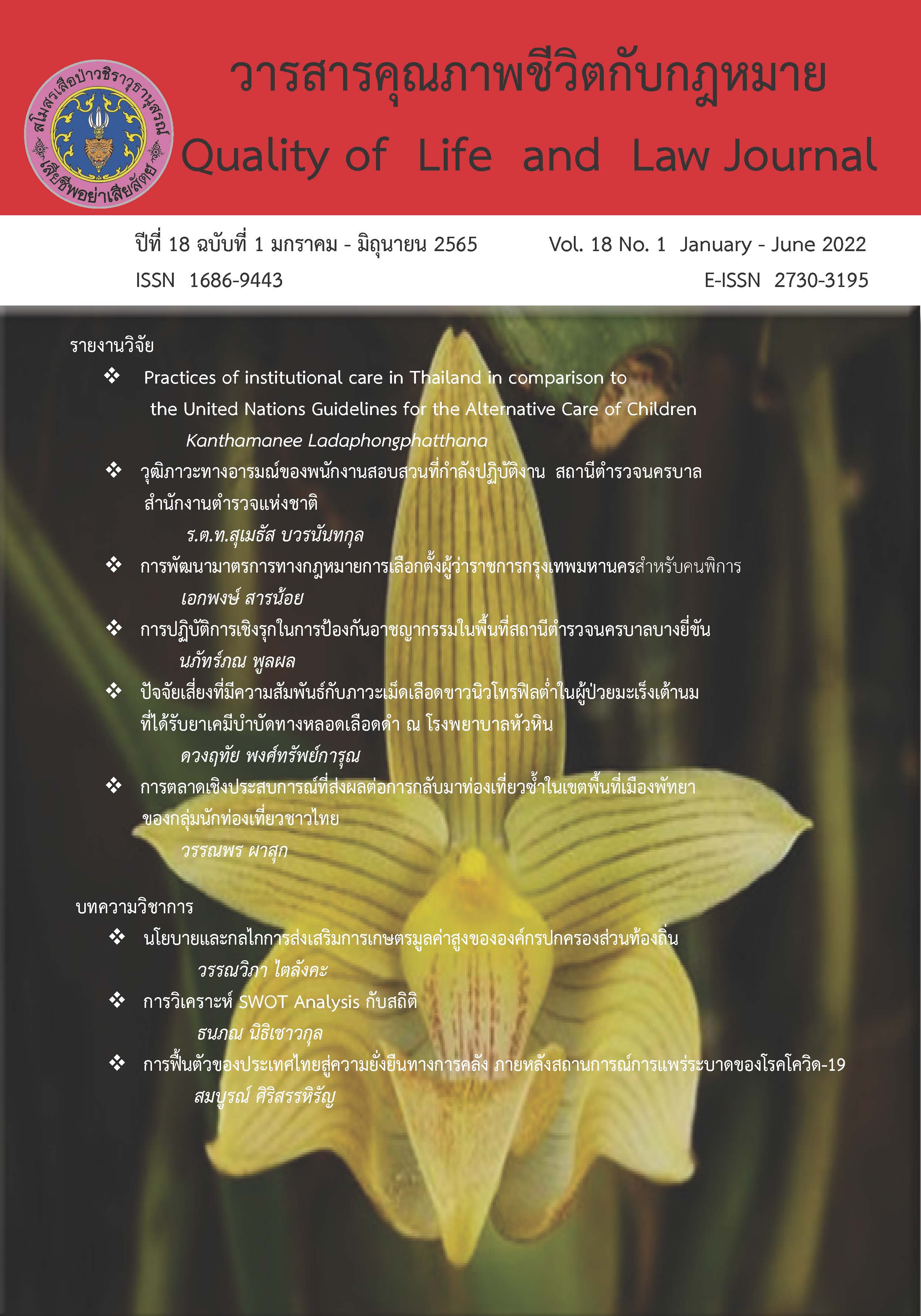Practices of institutional care in Thailand in comparison to the United Nations Guidelines for the Alternative Care of Children
Main Article Content
Abstract
This qualitative research studied the comparison between the practices of registered private institutional care facilities in Thailand and the United Nations Guidelines for the Alternative Care of Children. Six orphanages in Chiangmai province were selected through quota sampling. Six managers and twelve parents who sent or received their children back from the respective orphanages were selected as key informants for semi-structured in-depth interviews. The study found both the practices aligned and contradicted the guidelines. However, neither the aligned or contrary practices intentionally had the guidelines as thei base. The orphanages with social workers had distinctly better practices aligned to the guidelines in the four areas covered by this study; gatekeeping, individual care plan, family reintegration, and family strengthening. Based on the findings, recommendations are made for the Thai government and individual private orphanages in Thailand to close the gap between current practice and the intention exhibited in the Guidelines for the Alternative Care of Children.
Article Details

This work is licensed under a Creative Commons Attribution-NonCommercial-NoDerivatives 4.0 International License.
- บทความหรือข้อคิดเห็นใดๆ ในวารสารคุณภาพชีวิตกับกฎหมายเป็
- กองบรรณาธิการไม่สงวนสิทธิ์
References
Alternative Care Thailand. (2014). Exploring the “Orphan Myth” in Thailand. In Alternative Care Thailand (Ed.): Alternative Care Thailand.
Alternative Care Thailand. (2022). Database of private children’s homes in Thailand.
Cantwell, N. (2018). Institutional care, University of Strathclyde. https://www.futurelearn.com/courses/alternative-care/
Carr, A., Duff, H., & Craddock, F. (2020). A Systematic Review of Reviews of the Outcome of Severe Neglect in Underresourced Childcare Institutions. Trauma Violence Abuse, 21(3), 484-497. https://doi.org/10.1177/1524838018777788
Center on the Developing Child. (2021). 3 Principles to Improve Outcomes for Children and Families (2021 Update). Harvard University.
Children’s Bureau. (1967). The story of the White House Conferences on Children and Youth. https://files.eric.ed.gov/fulltext/ED078896.pdf
CRC Coalition Thailand. (2016). Report of Online Survey to Assess the extent of unregistered Children’s Homes in Thailand. CRC Coalition Thailand.
Department of Children and Youth. (2017). Khumư pramœn mattrathan songsœm kančhat sawatdikan sangkhom samrap dek nai sathan rongrap dek [Quality on promoting social welfare services provision for children in residential care assessment manual]. Department of Children and Youth.
Department of Children and Youth. (2020?). Reasons for accepting and ending care for children in residential care [sahet thi dek khao læ čhamnai ok čhak sathan rong rap].
Institute for Population and Social Research, & Unicef. (2016). The Impact of Internal Migration on Early Childhood Well-Being and Development: Baseline results of quantitative and qualitative surveys. Unicef. https://www.unicef.org/thailand/media/386/file/The%20Impact%20of%20Internal%20Migration%20on%20Early%20Childhood%20Well-Being%20and%20Development.pdf
International Care Leavers Convention. (2020). Key Takeaways. In.
Lumos. (2022). The Problem with orphanages. https://www.wearelumos.org/what-we-do/the-problem/
National Scientific Council on the Developing Child. (2012). The Science of Neglect: The Persistent Absence of Responsive Care Disrupts the Developing Brain: Working Paper 12. http://www.developingchild.harvard.edu
National Statistical Office, & Unicef. (2020). Thailand Multiple Indicator Cluster Survey 2019: Survey Findings Report. National Statistical Office. https://www.unicef.org/thailand/media/5146/file/Multiple%20Indicator%20Cluster%20Survey%202019.pdf
United Nations. (2009). Guidelines for the Alternative Care of Children.


